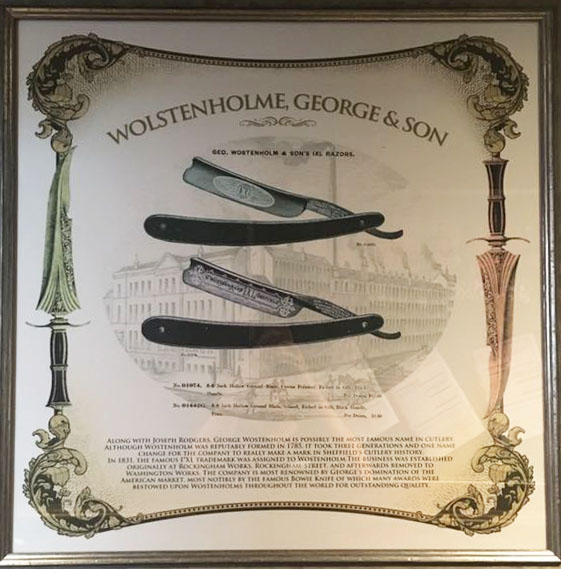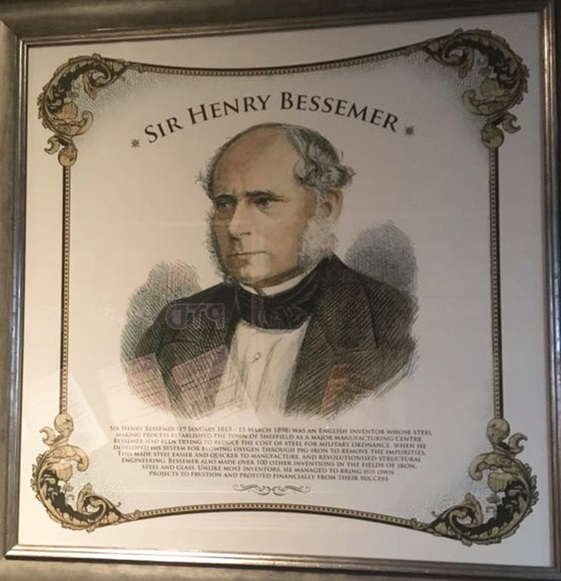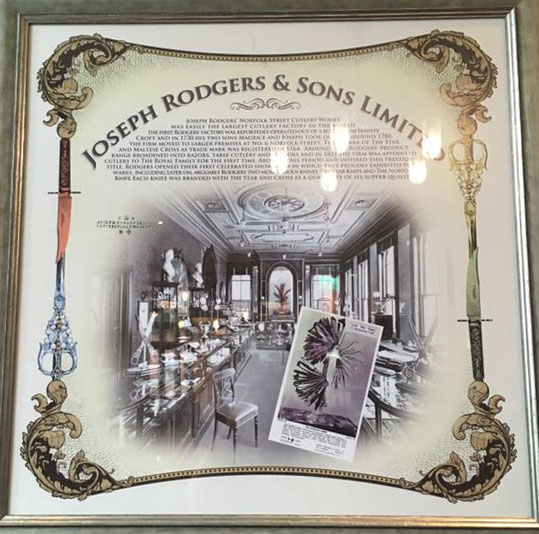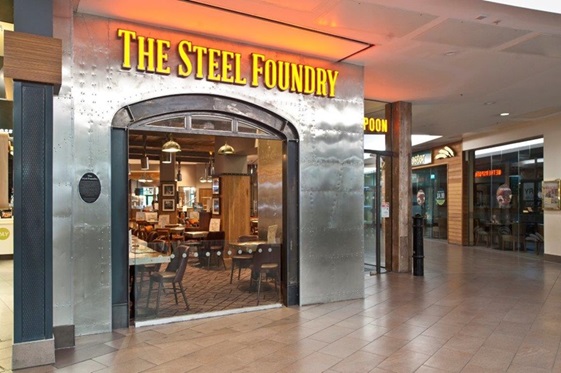One of Britain’s largest shopping centres, Meadowhall lies between the River Don and the M1 motorway. It opened on 5 September 1990, built on the site of Hadfield’s vast steel works. Robert Hadfield (junior) established his steel foundry on this site in 1897 and named it East Hecla, after one of Iceland’s most active volcanoes. Within a few years, it became a world-famous foundry and Sheffield’s leading employer. It ceased production in 1982.
Illustrations and text about George Wolstenholm.

The text reads: Along with Joseph Rodgers, George Wostenholm is possibly the most famous name in cutlery. Although Wostenholm was reputably formed in 1785, it took three generations and one name change for the company to really make a mark in Sheffield’s cutlery history. In 1831, the famous I*XL trademark was assigned to Wostenholm. The business was established originally at Rockingham Works, Rockingham Street, and afterwards removed to Washington Works. The company is most renowned by George’s domination of the American market, most notably by the famous Bowie Knife of which many awards were bestowed upon Wostenholms throughout the world for outstanding quality.
An illustration and text about Sir Henry Bessemer.

The text reads: Sir Henry Bessemer (19 January 1813 – 15 March 1898) was an English inventor whose steel making process established the town of Sheffield as a major manufacturing centre. Bessemer had been trying to reduce the cost of steel for military ordnance, when he developed his system for blowing oxygen through pig-iron to remove the impurities. This made steel easier and quicker to manufacture, and revolutionised structural engineering. Bessemer also made over 100 other inventions in the fields of iron, steel and glass. Unlike most inventors, he managed to bring his own projects to fruition and profited financially from their success.
A photograph and text about Joseph Rodgers & Sons Limited.

The text reads: Joseph Rodgers’ Norfolk Street cutlery works was easily the largest cutlery factory in the world. The first Rodgers factory was reportedly operated out of a building in Hawley Croft and in 1730 his two sons Maurice and Joseph took over, in around 1780, the firm moved to larger premises at No.6 Norfolk Street. Their mark of the star and Maltese cross as trade mark was registered in 1764. Around 1800, Rodgers’ product range broadened into razors, table cutlery and scissors and in 1821 the firm was appointed cutlers to the royal family for the first time. Around this period and inspired this prestigious title, Rodgers opened their first celebrated showroom in which they proudly exhibited their wares, including later on, arguably Rodgers two most famous knives, the Year Knife and the Norfolk Knife. Each knife was branded with the star and cross as a guarantee of its superb quality.
Illustrations and text about Thomas Boulsover.

The text reads: Thomas Boulsover was a Sheffield cutler and the inventor of Sheffield plate. He was born in 1705 in what is now the Ecclesfield district of Sheffield. Boulsover completed his apprenticeship as a cutler in 1726 and, around 1740 set up his own workshop on the corner of Tudor Street and Surrey Street in Sheffield’s city centre. It was at these premises that, in 1743, he discovered (by accident it is said, while repairing the handle of a knife) that silver could be relatively easily fused onto copper and that the resulting ‘sandwich’ could be fabricated effectively, by hammering and rolling, as one material while maintaining the outer appearance of pure silver. This material became known as Sheffield plate and Boulsover began to manufacture buttons, buckles, spurs and small boxes of the material, later moving on to create artistic, especialmente dishes and trays and hollowware such as coffee pots.
An illustration and text about the Company of Cutlers in Hallamshire.

The text reads: The Company of Cutlers in Hallamshire is a trade guild of metalworkers based in Sheffield. It was incorporated by an Act of Parliament in 1624 for:
“All persons using to make knives, blades, scissers, sheeres, sickles, cutlery wares and all other wares and manufacture made or wrought of yron and steele, dwelling or inhabiting within the said Lordship and Liberty of Hallamshire or within six miles compasse of the same”.
The head of the company is known as the master cutler. Their motto being “Pour Y Parvenir a Bonne Foi (To Succeed Through Honest Endeavour)”.
The company has been based at Cutlers’ Hall since 1638. The current hall is the third to have been built on the site.
Illustrations and text about Hadfield’s Steel Foundry Co Ltd.

The text reads: In 1872, Robert Hadfield began his own steel casting business Hadfield’s Steel Foundry Co. on a site close by the River Don, off Newhall Road, Attercliffe. Following his death in 1888 his son, leading metallurgist Robert Abbott Hadfield took over the business. By the mid 1890s, with work at high levels, the company needed to expand from their restrictive site and bought 90 acres of land in Tinsley. On this they built a new works, known as East Hecla Works which opened in 1897. In 1882 Robert discovered manganese steel and as such a specialty of Hadfield’s became the production of points and crossings for railway track work. The First World War provided new markets for manganese steel, spur armour plate and shells, tank treads and soldier’s helmets. By 1919 Hadfield’s were Sheffield’s biggest employers and were probably the largest special alloy steel manufacturer in the country. In the 1960s Hadfield’s Limited split into separate divisions, forging, casting and other works. The factory was eventually demolished in the 1980s and is now mainly covered by the Meadowhall shopping centre.
External photograph of the building – main entrance.

If you have information on the history of this pub, then we’d like you to share it with us. Please e-mail all information to: pubhistories@jdwetherspoon.co.uk